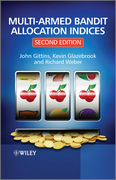
Multi-armed bandit allocation indices
Gittins, John
Glazebrook, Kevin
Weber, Richard
INDICE: Foreword. Preface. 1 Introduction or Exploration. Exercises. 2 MainIdeas: Gittins Index. 2.1 Introduction. 2.2 Decision processes. 2.3 Simple families of alternative bandit processes. 2.4 Dynamic programming. 2.5 Gittins index theorem. 2.6 Gittins index. 2.7 Proof of the index theorem by interchanging bandit portions. 2.8 Continuous-time bandit processes. 2.9 Proof of the index theorem by induction and interchange argument. 2.10 Calculation of Gittins indices. 2.11 Monotonicity conditions. 2.12 History of the index theorem. 2.13Some decision process theory. Exercises. 3 Necessary Assumptions for Indices.3.1 Introduction. 3.2 Jobs. 3.3 Continuous-time jobs. 3.4 Necessary assumptions. 3.5 Beyond the necessary assumptions. Exercises. 4 Superprocesses, Precedence Constraints and Arrivals. 4.1 Introduction. 4.2 Bandit superprocesses. 4.3The index theorem for superprocesses. 4.4 Stoppable bandit processes. 4.5 Proof of the index theorem by freezing and promotion rules. 4.6 The index theoremfor jobs with precedence constraints. 4.7 Precedence constraints forming an out-forest. 4.8 Bandit processes with arrivals. 4.9 Tax problems. 4.10 Near optimality of nearly index policies. Exercises. 5 The Achievable Region Methodology. 5.1 Introduction. 5.2 A simple example. 5.3 Proof of the index theorem by greedy algorithm. 5.4 Generalized conservation laws and indexable systems. 5.5Performance bounds for policies for branching bandits. 5.6 Job selection and scheduling problems. 5.7 Multi-armed bandits on parallel machines. Exercises. 6 Restless Bandits and Lagrangian Relaxation. 6.1 Introduction. 6.2 Restless bandits. 6.3 Whittle indices for restless bandits. 6.4 Asymptotic optimality. 6.5 Monotone policies and simple proofs of indexability. 6.6 Applications to multi-class queuing systems. 6.7 Performance bounds for the Whittle index policy. 6.8 Indices for more general resource configurations. Exercises. 7 Multi-Population Random Sampling (Theory). 7.1 Introduction. 7.2 Jobs and targets. 7.3 Use of monotonicity properties. 7.4 General methods of calculation: use of invariance properties. 7.5 Random sampling times. 7.6 Brownian reward processes. 7.7 Asymptotically normal reward processes. 7.8 Diffusion bandits. Exercises. 8 Multi-Population Random Sampling (Calculations). 8.1 Introduction. 8.2 Normal reward processes (known variance). 8.3 Normal reward processes (mean and variance both unknown). 8.4 Bernoulli reward processes. 8.5 Exponential reward processes. 8.6 Exponential target process. 8.7 Bernoulli/exponential target process. Exercises. 9 Further Exploitation. 9.1 Introduction. 9.2 Website morphing. 9.3 Economics. 9.4 Value of information. 9.5 More on job-scheduling problems. 9.6 Military applications. References. Tables. Index.
- ISBN: 978-0-470-67002-6
- Editorial: John Wiley & Sons
- Encuadernacion: Cartoné
- Páginas: 312
- Fecha Publicación: 18/03/2011
- Nº Volúmenes: 1
- Idioma: Inglés
